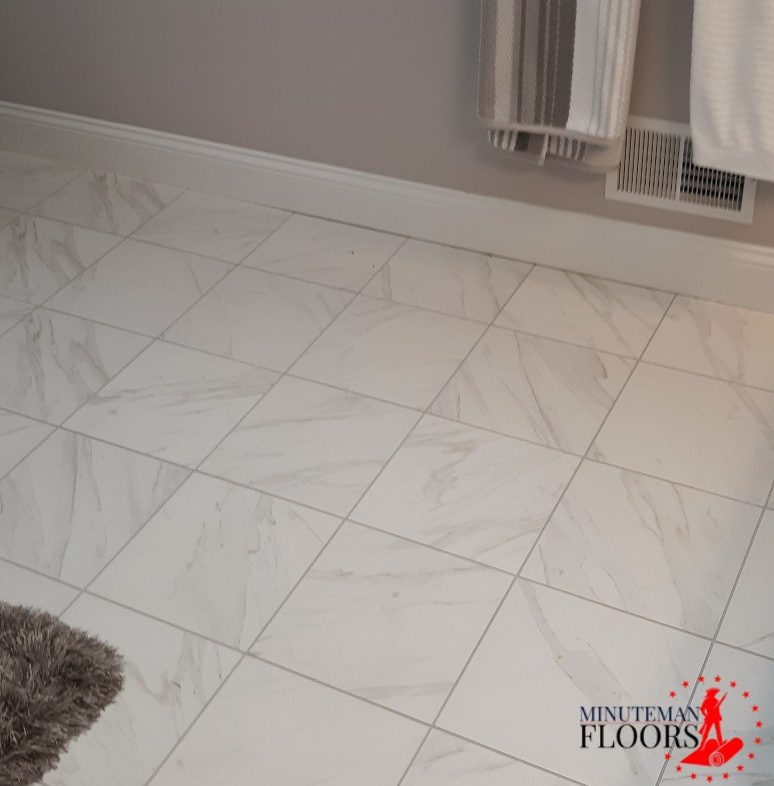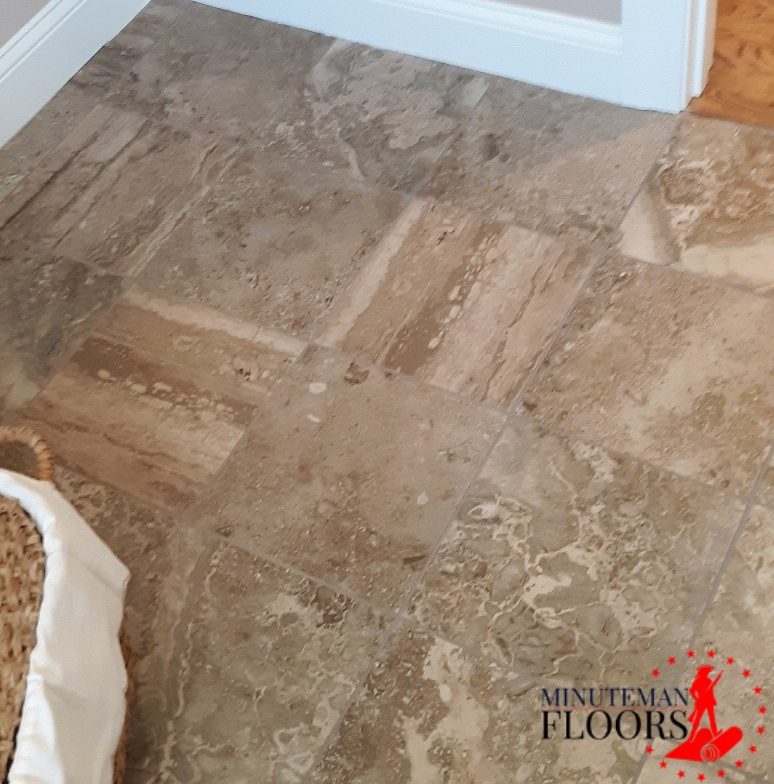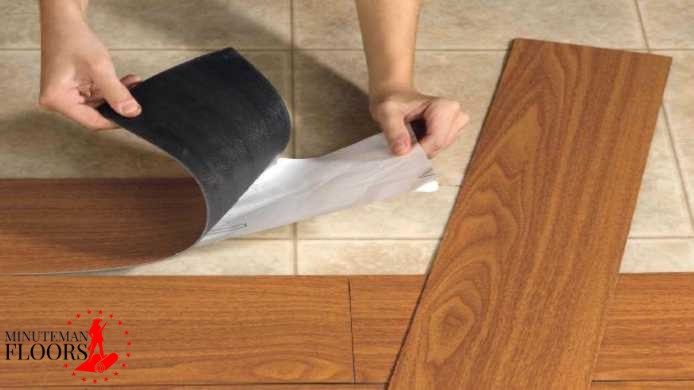Installing vinyl plank flooring throughout your home doesn’t have to be a chore. You don’t have to be Bob Vila, nor do you need a truckload of tools. With a single afternoon set aside, you can have brand-new floors that shine. Your flooring can look any way you choose, your imagination is the limit.
To help you out, we have compiled the complete guide to installing vinyl plank flooring by yours truly. As expert home flooring installation specialists, we know a thing or two about plank floors. If there’s a single piece of advice we can give you, it’s to choose your floor design wisely. You don’t want buyer’s remorse as you are looking down at your newly laid plank tiles.
However, if you have the perfect style in mind, whether it’s wood, stone, or any other, this guide should help you make quick and easy work of your home flooring installation job.
Use Luxury Vinyl Floor Planks
We recommend that you use LVP or luxury vinyl planks, which are thinner than ceramic tile and even wood tiles. The best part is that these planks don’t require an underlayment, so you can go right over your existing floor without raising the surface too much.
Keep in mind that if you select floating vinyl flooring, the planks will have to be installed on a smooth surface. Therefore, it is best not to install floating vinyl planks on tile.

Prime Benefits of Using LVP Flooring
Luxury vinyl planks are water-resistant, soft, pliable, and easy to cut. This makes the planks easily malleable and customizable for every application. You also don’t need a lot of tools to install vinyl flooring. We do recommend a tapping block, pull bar, and shims, which can help you position the planks into place. Other tools are optional, as we will explain as we delve into the floor installation process.
Tips for Installing Vinyl Plank Flooring
We also recommend that you get some sandpaper if you are installing your vinyl flooring on a subfloor. The subfloor you use as your installation medium should be free of any humps or bulges, so be sure and grind these down. An electric sander will make quick work of the job. When using sandpaper or a sander, stick to 40 or 60-grit paper.
If you notice any low spots in your subfloor, you can fill these in with a floor patch, then feather the excess out with a trowel. You can ignore the screw heads, as they won’t be a hindrance when installing the vinyl tiles.
If you are using a concrete subfloor, the flooring should be at least six weeks old, dry, and free of powder or cracks. If you notice cracks or expansion joints in your concrete subfloor, fill these in with floor patch and feather them with a trowel as before. Avoid self-leveling floor patch. The floor doesn’t necessarily have to be level, as long as it is smooth.
Now you are ready to install the vinyl floor planks. Before you lay the first row of planks, you should figure out how long your last row has to be. Laying vinyl planks is a precision job, at least if you want an aesthetically pleasing finish. Therefore, measure twice and cut once for best results.
For the most eye-catching flooring, make sure the first and last rows of planks are never cut more than half a plank. Ideally, both rows should be even.
You can find the proper dimensions by measuring the width of the room and dividing it by the exposed portion of the planks before you start installing your flooring. For instance, if your room measures 140 inches and your flooring is 5.75 inches wide, you divide 140 by 5.75, which equals 24.35. So, it would take 24.35 planks to complete your entire floor. Because the .35 equals half the width of a standard plank, you would cut the first plank by around an inch to increase the size of the final plank.
Tips for Cutting Vinyl Plank Flooring
LVP flooring is one of the easiest flooring selections to cut. In reality, you are not so much as cutting the tile as you are breaking it. Using a sharp utility knife (don’t use a boxcutter) and a straight edge, score the hard wear layer on the top surface, then bend the layer back until it snaps in half. Yes, cutting vinyl flooring is that easy. Be sure and cut the planks so that the cut edge faces the wall. These cut edges will be covered by molding when the installation is finished.
The method above is known as a straight cut. There is also a crosscut, which is designed to make a plank shorter. The cut is made perpendicular to its length and, therefore, some find it difficult to get the cut straight. Again, measure twice and then make the cut – or break – once for the most symmetrical results.

How to Install Vinyl Flooring Planks Along Walls and on Corners
When installing the planks along walls, insert shims, which are tiny devices that will leave a slight gap between the flooring and the wall. These gaps allow the flooring to expand as the temperature in your home changes.
For best results, leave a ¼ inch to 3/8-inch gap between the flooring and each wall.
For door jambs, you can undercut the wood using an oscillating multi-tool so that you can slide the flooring underneath. When cutting, you can use a scrap of your flooring as a measuring guide.
How to Install Peel and Stick Vinyl on Plywood?
Installing vinyl floor planks is as easy as a breeze. All you need to do is tear off the backing and then snap the planks where you want. Apart from offering the ease to install, these floors are comfortable and easy to manage as well.
Get started with laying the first row of vinyl floor planks. Then, once the first row is complete, slide the tongue of the first plank of the second row into the tiny groove of the first-row plank, and lay it down. The second and subsequent rows will lock the previous planks into position. This process allows your floor to lay evenly, albeit with just enough flexibility, to truly shine.
What is the Best Transition to Install Between Carpet and Vinyl Flooring?
If you are installing vinyl flooring in the kitchen and your dining room has carpet, for example, remember that sheet vinyl planks will leave a ¼ inch underlayment beneath it. Carpet does not have this underlayment. Therefore, before laying your vinyl tile down, you will want to remove the underlayment in the kitchen or add some to the carpet in the dining room.
Carpeting Selections & Installations in Manchester
What About the Seams?
We recommend that you stagger the seams of your tile. For instance, you can use the partial planks that are left over from the first row as the starter on the second. You can do the same for the third and subsequent rows. This staggers the seams at least six inches apart. For best results, don’t start or end a row with any plank less than six inches wide. You might want to open several boxes of vinyl and mix them to ensure your floor pattern is varied.
Simply snap the planks together and work your way down each row. Before you know it, your entire floor will be installed to your satisfaction.
For Stubborn End Planks
If you encounter any planks that don’t want to cooperate, hook a pull bar onto the end of the tile and tap the stubborn seam closed. When installed properly, each seam should be smooth to the touch and nearly invisible.
What are Additional Features Many Forget When Installing Vinyl Flooring?
Once your flooring is installed, you will want to cover the expansion gap between the flooring and base trim. This job can be accomplished by using shoe molding, then shoot 1 ¼ inch finish nails through each shoe and into the trim. Take care that you don’t pin the flooring down. The molding should be finished to match the trim, not the flooring itself.
Installing Vinyl Plank Flooring in the Bathroom
Vinyl plank flooring is an excellent choice for the bathroom. Each tile stands up to moisture and stains and, no matter the texture, the flooring is a joy to walk on. The flooring can also be installed over your existing floor for an easy afternoon project.
Bathroom vinyl can look shoddy if the job isn’t done right. For that reason, we recommend that you only trust your bathroom vinyl flooring installation to the professionals. We have the tools and training to lay the ideal flooring design in your bathroom for a low-maintenance floor choice that always looks its best.
Installing Vinyl Plank Flooring in the Basement
For basements with a nice even concrete subfloor, we recommend durable vinyl sheet flooring. This flooring option is comprised of fiberglass-reinforced floor tiles that cover concrete subfloors with ease.
Installing this vinyl flooring option is simple, as it comes in one big sheet you simply cut and fit into place. For larger spaces that may require more than one sheet, you can seam the pieces together with a single strip of double-sided tape placed underneath the seam. For best results, seal the seam over with the manufacturer’s seam sealant to create a smooth and water-resistant joint.
Be sure and leave a gap along the walls and that you cover the gaps after installation with quarter-round or shoe molding.
Installing Vinyl Plank Flooring in the Kitchen
The methods and techniques used to install vinyl planks vary depending on where you want to install them. If your kitchen has a center island, the planks will be laid after removing the island. Likewise, an extra subfloor will need to be laid for cabinets that are placed directly on plywood. This is done to achieve uniform installation. The technician will overlap the subfloor joints and line up the edges and the joints in a way which makes the vinyl planks installation perfect.
For best results, cover the entire floor with builder’s felt (15 pounds) or an underlayment. Most vinyl plank manufacturers recommend the type of underlayment you should use. The underlayment can be cut with a utility knife and stapled to the subfloor with each staple spaced around 24 inches apart. If you have staples that won’t go all the way into the floor, tap each one into place with a hammer until all of them are flush.
The installation can proceed as with any peel-and-stick vinyl flooring job, ensuring there are gaps at the edges and that the gaps are sealed with molding.
Installing Vinyl Plank Flooring on the Staircase
Don’t install vinyl tiles where vinyl sheets should go. For example, vinyl tiles are an ideal match for stair installations. It is easy to take care of tiles as compared to sheets. Vinyl sheets for the edge of the stairs, however, sound good.
You can also use vinyl stair treads, the pieces that go over the edge of stairs. This is an alternative choice to cutting tiles to cover the front of the stairs, allowing you to simply use the treads instead.
As with all vinyl flooring installations, make sure your stair subfloor is even. If you are laying over your existing floor, be sure to get rid of any bumps before you begin. You can use caulking and seal joints to cover screws in your subfloor, and the surface should be cleaned thoroughly before the first vinyl tiles are laid down.
Then, simply peel and stick your vinyl tiles, making sure you work out any air bubbles as you go. Before long, your stairs will be covered and sealed with the ideal flooring you picked out.
Do You Have to Remove Vinyl Flooring before Installing Laminate?
A question we often get from Manchester homeowners is whether laminate flooring can be used over vinyl flooring. Yes, it is possible to lay laminate over vinyl. However, there are some points to consider.
Before installing the laminate flooring, make sure your vinyl tiles are level and in excellent condition. You should also clean the vinyl so that each section is free of debris. If the condition of the vinyl leaves much to be desired, you can lay an underlayment on top of the vinyl subfloor before you begin.
Alternatively, you may consider pulling the vinyl flooring up if the tile is in poor condition and when the vinyl was glued down when it was installed.
Call Now for Vinyl Flooring Installation Done Right in Manchester, New Hampshire
As you can see, vinyl flooring is a cinch to lay down for pretty much any room. While installing vinyl flooring planks may be quick and easy, only a professional floor installer with experience and training can ensure a job well-done. At Minuteman Floors, we work with dozens of floor brands and designs to give you what you want for less.
When it comes to vinyl tile, we can help you select the water-resistant and stain-resistant option you need for any area of your home, indoors or out. Want vinyl for the bathroom, kitchen, or stairs? Our vinyl flooring installation professionals have you covered. Call now for residential or commercial installation, and let’s discuss the vinyl flooring options that would be perfect for your needs and budget.

